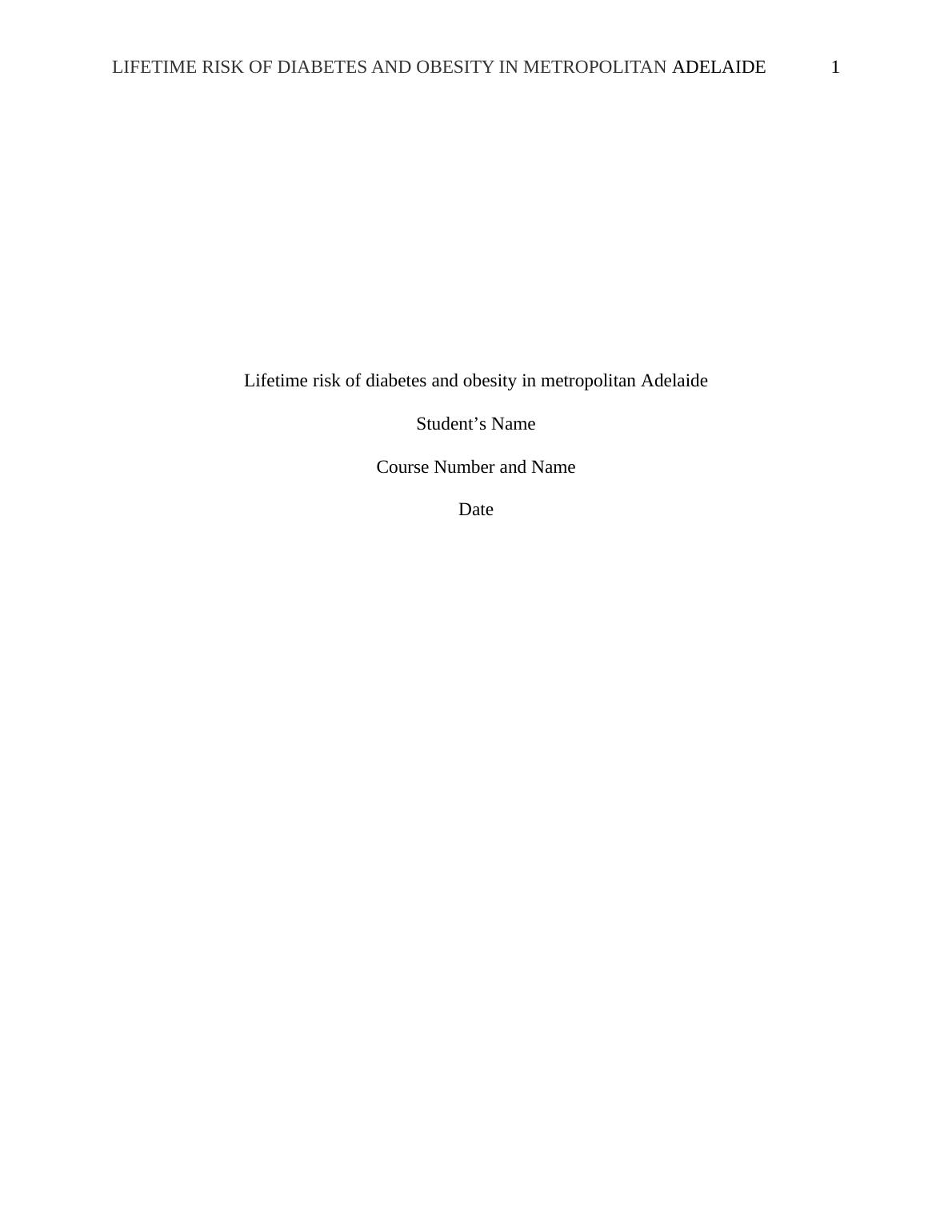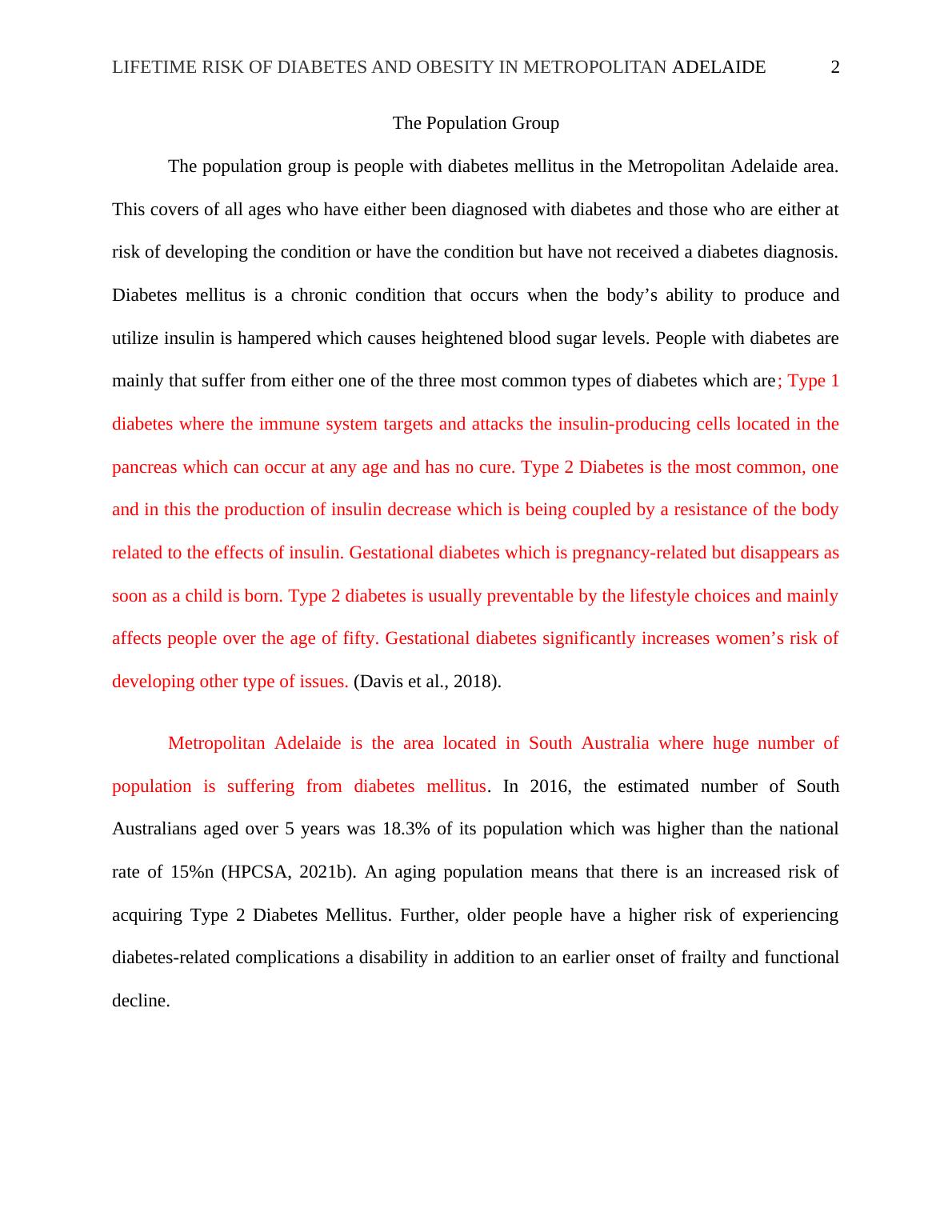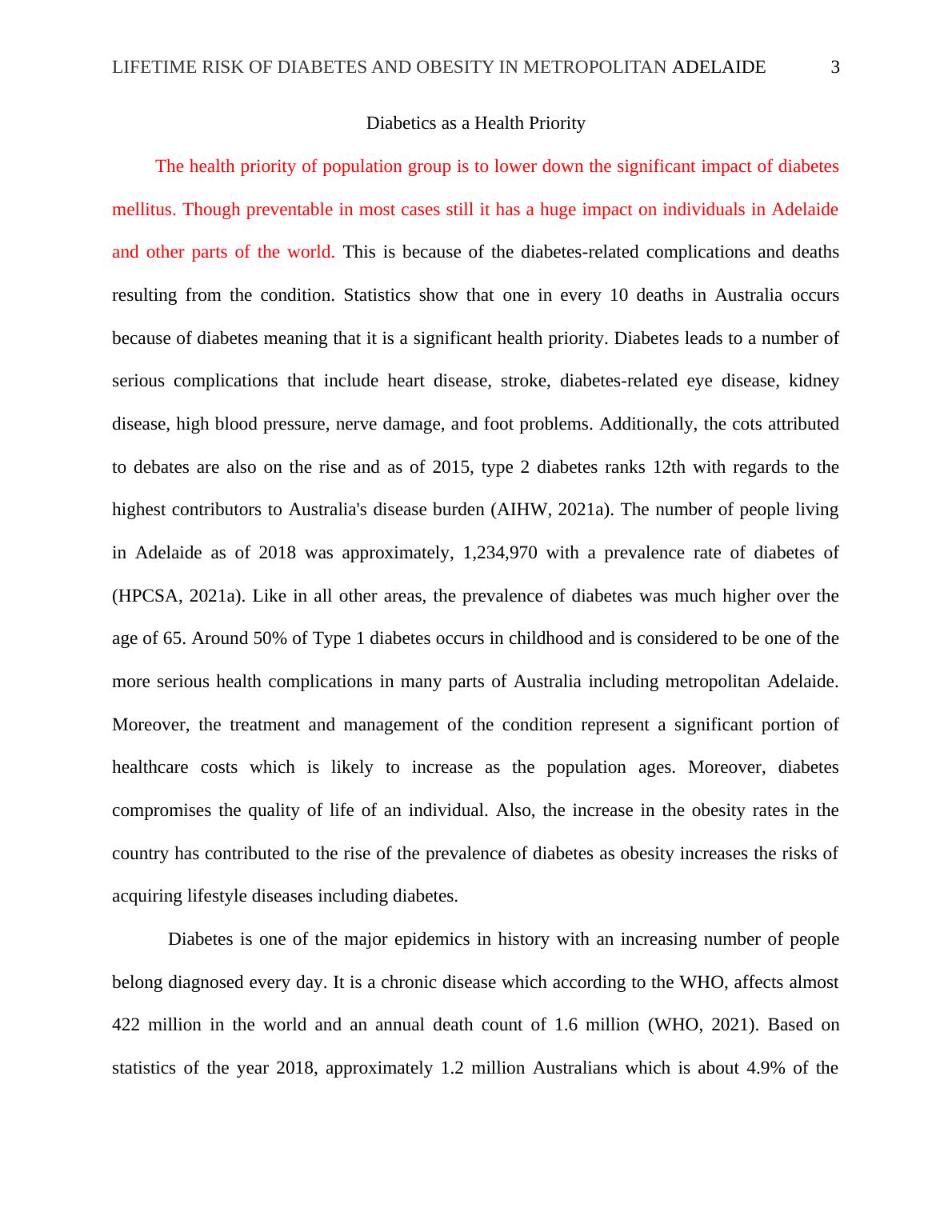Lifetime Risk of Diabetes and Obesity in Metropolitan Adelaide
Added on 2022-12-27
9 Pages2306 Words67 Views
LIFETIME RISK OF DIABETES AND OBESITY IN METROPOLITAN ADELAIDE 1
Lifetime risk of diabetes and obesity in metropolitan Adelaide
Student’s Name
Course Number and Name
Date
Lifetime risk of diabetes and obesity in metropolitan Adelaide
Student’s Name
Course Number and Name
Date

LIFETIME RISK OF DIABETES AND OBESITY IN METROPOLITAN ADELAIDE 2
The Population Group
The population group is people with diabetes mellitus in the Metropolitan Adelaide area.
This covers of all ages who have either been diagnosed with diabetes and those who are either at
risk of developing the condition or have the condition but have not received a diabetes diagnosis.
Diabetes mellitus is a chronic condition that occurs when the body’s ability to produce and
utilize insulin is hampered which causes heightened blood sugar levels. People with diabetes are
mainly that suffer from either one of the three most common types of diabetes which are; Type 1
diabetes where the immune system targets and attacks the insulin-producing cells located in the
pancreas which can occur at any age and has no cure. Type 2 Diabetes is the most common, one
and in this the production of insulin decrease which is being coupled by a resistance of the body
related to the effects of insulin. Gestational diabetes which is pregnancy-related but disappears as
soon as a child is born. Type 2 diabetes is usually preventable by the lifestyle choices and mainly
affects people over the age of fifty. Gestational diabetes significantly increases women’s risk of
developing other type of issues. (Davis et al., 2018).
Metropolitan Adelaide is the area located in South Australia where huge number of
population is suffering from diabetes mellitus. In 2016, the estimated number of South
Australians aged over 5 years was 18.3% of its population which was higher than the national
rate of 15%n (HPCSA, 2021b). An aging population means that there is an increased risk of
acquiring Type 2 Diabetes Mellitus. Further, older people have a higher risk of experiencing
diabetes-related complications a disability in addition to an earlier onset of frailty and functional
decline.
The Population Group
The population group is people with diabetes mellitus in the Metropolitan Adelaide area.
This covers of all ages who have either been diagnosed with diabetes and those who are either at
risk of developing the condition or have the condition but have not received a diabetes diagnosis.
Diabetes mellitus is a chronic condition that occurs when the body’s ability to produce and
utilize insulin is hampered which causes heightened blood sugar levels. People with diabetes are
mainly that suffer from either one of the three most common types of diabetes which are; Type 1
diabetes where the immune system targets and attacks the insulin-producing cells located in the
pancreas which can occur at any age and has no cure. Type 2 Diabetes is the most common, one
and in this the production of insulin decrease which is being coupled by a resistance of the body
related to the effects of insulin. Gestational diabetes which is pregnancy-related but disappears as
soon as a child is born. Type 2 diabetes is usually preventable by the lifestyle choices and mainly
affects people over the age of fifty. Gestational diabetes significantly increases women’s risk of
developing other type of issues. (Davis et al., 2018).
Metropolitan Adelaide is the area located in South Australia where huge number of
population is suffering from diabetes mellitus. In 2016, the estimated number of South
Australians aged over 5 years was 18.3% of its population which was higher than the national
rate of 15%n (HPCSA, 2021b). An aging population means that there is an increased risk of
acquiring Type 2 Diabetes Mellitus. Further, older people have a higher risk of experiencing
diabetes-related complications a disability in addition to an earlier onset of frailty and functional
decline.

LIFETIME RISK OF DIABETES AND OBESITY IN METROPOLITAN ADELAIDE 3
Diabetics as a Health Priority
The health priority of population group is to lower down the significant impact of diabetes
mellitus. Though preventable in most cases still it has a huge impact on individuals in Adelaide
and other parts of the world. This is because of the diabetes-related complications and deaths
resulting from the condition. Statistics show that one in every 10 deaths in Australia occurs
because of diabetes meaning that it is a significant health priority. Diabetes leads to a number of
serious complications that include heart disease, stroke, diabetes-related eye disease, kidney
disease, high blood pressure, nerve damage, and foot problems. Additionally, the cots attributed
to debates are also on the rise and as of 2015, type 2 diabetes ranks 12th with regards to the
highest contributors to Australia's disease burden (AIHW, 2021a). The number of people living
in Adelaide as of 2018 was approximately, 1,234,970 with a prevalence rate of diabetes of
(HPCSA, 2021a). Like in all other areas, the prevalence of diabetes was much higher over the
age of 65. Around 50% of Type 1 diabetes occurs in childhood and is considered to be one of the
more serious health complications in many parts of Australia including metropolitan Adelaide.
Moreover, the treatment and management of the condition represent a significant portion of
healthcare costs which is likely to increase as the population ages. Moreover, diabetes
compromises the quality of life of an individual. Also, the increase in the obesity rates in the
country has contributed to the rise of the prevalence of diabetes as obesity increases the risks of
acquiring lifestyle diseases including diabetes.
Diabetes is one of the major epidemics in history with an increasing number of people
belong diagnosed every day. It is a chronic disease which according to the WHO, affects almost
422 million in the world and an annual death count of 1.6 million (WHO, 2021). Based on
statistics of the year 2018, approximately 1.2 million Australians which is about 4.9% of the
Diabetics as a Health Priority
The health priority of population group is to lower down the significant impact of diabetes
mellitus. Though preventable in most cases still it has a huge impact on individuals in Adelaide
and other parts of the world. This is because of the diabetes-related complications and deaths
resulting from the condition. Statistics show that one in every 10 deaths in Australia occurs
because of diabetes meaning that it is a significant health priority. Diabetes leads to a number of
serious complications that include heart disease, stroke, diabetes-related eye disease, kidney
disease, high blood pressure, nerve damage, and foot problems. Additionally, the cots attributed
to debates are also on the rise and as of 2015, type 2 diabetes ranks 12th with regards to the
highest contributors to Australia's disease burden (AIHW, 2021a). The number of people living
in Adelaide as of 2018 was approximately, 1,234,970 with a prevalence rate of diabetes of
(HPCSA, 2021a). Like in all other areas, the prevalence of diabetes was much higher over the
age of 65. Around 50% of Type 1 diabetes occurs in childhood and is considered to be one of the
more serious health complications in many parts of Australia including metropolitan Adelaide.
Moreover, the treatment and management of the condition represent a significant portion of
healthcare costs which is likely to increase as the population ages. Moreover, diabetes
compromises the quality of life of an individual. Also, the increase in the obesity rates in the
country has contributed to the rise of the prevalence of diabetes as obesity increases the risks of
acquiring lifestyle diseases including diabetes.
Diabetes is one of the major epidemics in history with an increasing number of people
belong diagnosed every day. It is a chronic disease which according to the WHO, affects almost
422 million in the world and an annual death count of 1.6 million (WHO, 2021). Based on
statistics of the year 2018, approximately 1.2 million Australians which is about 4.9% of the

End of preview
Want to access all the pages? Upload your documents or become a member.
Related Documents
Diabetes among Aboriginal and Torres Strait Islander people in Australialg...
|8
|2145
|210
The National Health Priority Areas (NHPA)lg...
|9
|2380
|29
Youth Diabetes Type 2lg...
|7
|1680
|44
Anatomy and Physiology of Diabetes Mellitus Type 2lg...
|9
|3273
|83
Risk of Thrombosis in Type 2 Diabetes Mellituslg...
|4
|1838
|88
Diabetes Mellitus in Bottlebrush Hospitallg...
|8
|2133
|278
